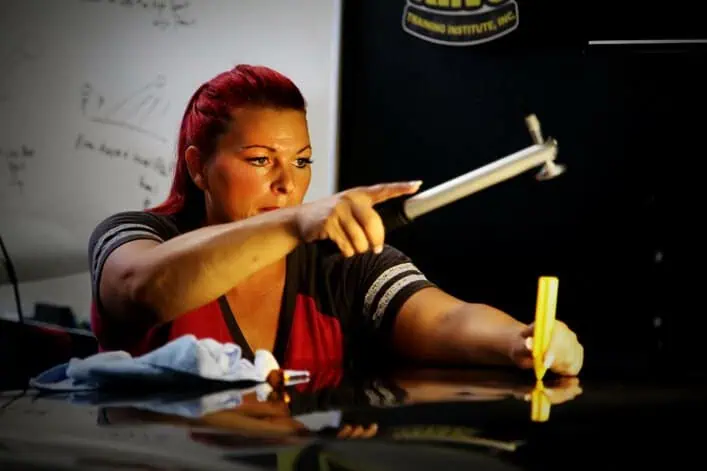Mastering Blending and Finishing in Paintless Dent Repair
At Dent Repair School, students learn that the removal of a dent is only the beginning of a professional-grade repair. The final stage—blending and finishing—determines whether the repair is visible or invisible. While pushing the dent back to its natural shape is essential, the surface often requires precise refinement to achieve perfect reflection. This finishing work is what separates trained professionals from beginners. The ability to blend transitions, smooth micro-highs, and restore the natural flow of light across the panel is the hallmark of true craftsmanship in Paintless Dent Repair (PDR).
Finishing is about control. The technician must use subtle and deliberate movements to refine the repaired area until it aligns perfectly with the surrounding surface. Even a perfectly lifted dent can reveal texture if not finished correctly. Light movement, gentle tool placement, and surface awareness are required to complete this step. Dent Repair School teaches students to develop a trained eye that can read reflection with accuracy and make micro-adjustments that enhance quality.
“Removing the dent restores shape. Finishing restores the illusion that the dent was never there.”
Why Finishing Matters
The paint surface is a reflective layer. Any small inconsistency, no matter how shallow, disrupts that reflection. Finishing corrects these inconsistencies. Without proper finishing, the repair may appear slightly hazy, uneven, or rippled under certain angles. With correct technique, the repair blends perfectly into the panel so that no trace remains.
Finishing requires:
-
Accurate reflection interpretation
-
Controlled blending hammer taps
-
Ability to identify and correct micro-high and micro-low points
-
Patience and slow refinement rather than force
This stage cannot be rushed because perfection is achieved in small movements.
The Role of the Blending Hammer
The blending hammer is used to refine the surface by tapping down high points to match the surrounding reflection. It is not used to flatten the panel, but to merge surface transitions. The angle of the hammer, the height of the strike, and the rhythm of tapping influence the final surface texture. Students learn to synchronize hand movement with what the reflection reveals. When done correctly, blending creates seamless visual integration.
A skilled technician is not only pushing dents out—they are sculpting reflection.
Blending and Finishing Technique Comparison
| Technique | Purpose | Skill Required | Effect on Reflection | When Applied |
|---|---|---|---|---|
| Blending Hammer Finishing | Smooth out high spots and transitions | High | Restores consistent light flow | After main dent lift is completed |
| Knockdown Precision Work | Remove defined micro-highs | Medium to High | Sharp correction of localized areas | Throughout refinement stage |
| Panel Re-Surfacing via Light Finishing | Balance texture across larger areas | Medium | Softens visible surface inconsistencies | Final visual blending |
Finishing is not a single action— it is a sequence of adjustments that refine the entire repair.
Learning to See What Others Do Not
The hardest part of finishing is visual awareness. The reflection grid or light board becomes the technician’s guide. Subtle waves in reflection show incomplete areas. Straight, uniform reflection lines confirm success. Students train to identify discrepancy patterns and read surface optics with confidence. As finishing skill grows, repair quality becomes consistently professional.
What others call “good enough,” a trained technician sees as incomplete.
Key Takeaways
Blending and finishing are essential for making repairs truly invisible.
The blending hammer is used to refine transitions and restore reflection flow.
Finishing requires patience, light control, and a trained eye for reflection.
Perfect repairs come from small corrections, not force or speed.
FAQs
Q: Why do some repairs look good until viewed in sunlight?
Because the repair may lack proper finishing, and sunlight reveals reflection inconsistencies.
Q: Do beginners struggle most with blending or pushing dents?
Beginners typically learn to push dents first; blending skill develops with practice and reflection awareness.
Q: How long does it take to become confident in finishing?
Confidence grows as reflection reading improves, which develops through guided repetition and mentorship.
Conclusion
Blending and finishing are the final touch that elevate a dent repair from acceptable to invisible. It is the stage where careful attention, refined skill, and visual precision come together to create a flawless result. At Dent Repair School, students learn not just how to remove dents, but how to restore the natural beauty and clarity of the panel. The technician who masters finishing does more than fix dents—they restore the surface as though the damage never existed.



